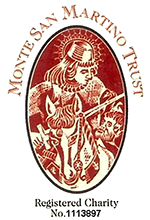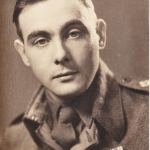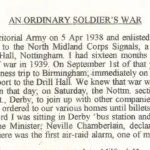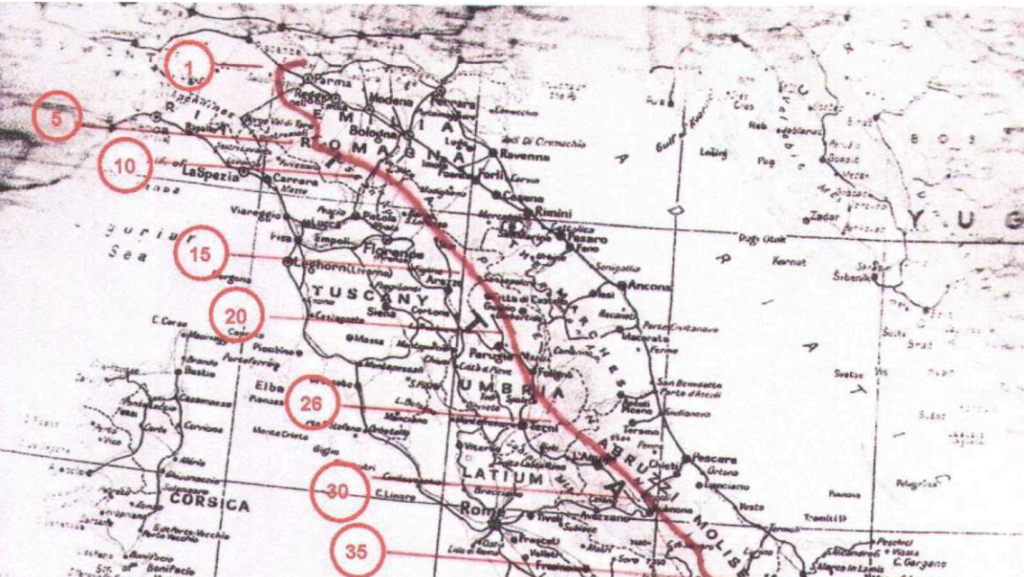Summary
Richard Hodgson was part of 149 Squadron for the RAF [Royal Air Force] during World War 2 where he flew over 29 missions piloting Wellington bombers. His account details one particular mission to bomb the refinery at Porto Marghera near Venice in Italy on 12th January 1941. During this mission his Wellington was hit by enemy anti-aircraft fire and he landed in mud and water amongst the islands of Venice.
Hodgson survived along with all his crew and they were rescued by Italian firefighters who handed them over to the local police. They were detained on the Island of Poveglia before eventually being transferred to a prison camp near Sulmona where they remained until the Italian Armistice of September 1943.Upon escaping they headed South where they eventually reached Allied forces just outside Naples.
The full story follows, in two versions. The version in the first window below is the original scanned version of the story. In the second window below is the transcribed version in plain text.
[Editor’s note: Newspapers in this file have been removed for copyright reasons. They are:
Il Gazzattino de Venezia, 2 May 1996 ‘Vacanze Veneziane per il Navigatore di un aereo inglese abbattuto nel 1941: In Laguna 55 anni dopo quel volo’;
Uniformi April 1994. ‘Ricordo quell giorno’;
An unidentified publication with a serialised article titled ‘Richard Hodgson: Quel primo volo a Venezia’.
The English text in the file below is a translation of the serialised article.
Deleted correspondence shows that Les Hatherley sent the articles to Keith Killby in 1998.
If you wish to consult the original articles or correspondence please contact the MSM Trust.
[Digital page 1]
[Handwritten notes by Keith Killby]
Richard Hodgson
Les Hatherley
By shot-down plane from England.
Landing on the Giudecca Island in Venice.
Photos of Plane & Italian Newspaper Cuttings. [Editor’s note: these are the articles cannot be published on the internet for copyright reasons]
[Digital page 2]
I REMEMBER THAT DAY – THAT FIRST FLIGHT TO VENICE:
RICHARD HODGSON.
After the war I was employed as a Captain by British European Airways, the British flag carrying airline. I operated frequently on the London – Venice sector but none of the passengers that I carried knew of my first “landing” at Venice.
I started the engines of the Vickers Wellington Mark 1 medium bomber on the evening of the 12th January, 1941, and I replied to the greetings of the ground crew around the aircraft. At 8 pm I started trundling out to the take off runway for what was due to be my last bombing mission. I had already carried out 29 missions, for the most part on Germany and I had received instructions that I was to be transferred as an Instructor on Wellingtons. The aircraft was quite new and it was equipped with the most modern instruments: it had an auto pilot which was somewhat capricious, and the navigator had a new projector which enabled him rapidly to convert sextant readings of the stars into points on the map.
All was ready for this raid which was to be amongst the longest undertaken by the RAF [Royal Air Force]. Propaganda advantages were foreseen in the destruction of a part of the precious reserve of petrol of the Italian Royal Navy in the far distant Venice. Extra fuel tanks were carried in the bomb bay of the aircraft in order to supply the necessary fuel for a long flight of about 1,500 miles that would take perhaps 10 hours with one hour of reserve. The Wellington, therefore, had a total range of 11 hours of flight. For this mission It was only possible to carry eight bombs of 250 pounds about half the normal amount carried by the twin engined machine.
Six Wellingtons of 149 Squadron of night bombers (motto Fortis Nocte) took off from their base at Mildenhall in Suffolk following different routes across France and South Germany in the direction of North Italy. Over England, very cloudy and the last thing I was able to recognise was the Lighthouse at Orford Ness which to my great surprise was functioning as normal despite the blackout. Presumably there was a convoy of ships in the vicinity of the coast. Atmospheric conditions for the flight were forecasted to be good and in particular the Alps should be free of cloud which would be a great help since it would be necessary to climb to 18,000 feet to avoid the mountains if they were covered in cloud. We could then fly much lower truly in the middle of the mountains.
We had other foreseeable problems for our return to Mildenhall since fog was forecasted. The new auto pilot soon packed up and from then on I had to pilot the twin engine aircraft manually. Little by little we proceeded slowly towards better weather but it was very cold. There was no heating and the temperature in the fuselage was at least 20 degrees C below zero whilst we were flying at 12,000 feet. We were all wearing leather flying suits with fur lined boots, Only McAnally and Pummery (rear and front gunners) had a rudimentary electric heating system incorporated in their flying suits since they
[Digital Page 3]
were forced to remain immobile for many hours in their lonely turrets. Hatherly, the navigator, was very satisfied with his new instrumentation and accurately maintained the course to the objective. As we approached the Alps the sky was clear; doubtless the countries over which we were flying had not previously seen or heard night bombers of the RAF [Royal Air Force]. No fighter has risen to intercept us and no anti-aircraft gun has opened fire despite the presence of a splendid full moon which appeared as we approached the mountains. Beneath us, some low clouds but the Alps could be seen clearly and the crew was fascinated with the beauty of the Dolomites that we were crossing in the direction of Bolzano. The strong light of the moon was reflected on the ice and on the snow and it seemed to us that we were flying in the middle of millions of splendid diamonds.
OVER VENICE.
We begin to descend and the navigator verified accurately our position confirming the route. There is no real need for this because we could distinguish very clearly the lagoon and the City of Venice. To our great and pleasant surprise we met little anti aircraft reaction during our approach to our objective, especially compared with the very violent reactions which we had become accustomed to in previous raids on Germany.
The primary objective was the refinery of Porto Marghera with the secondary objective being a little island adjoining Venice, the site of a petroleum deposit of the Regia Karina, I decided to opt for the second and in order to achieve the greatest accuracy I descended to a low level. At low level it was possible to drop the eight bombs with great precision and our target was now truly in front of the nose of our Wellington. At about 3,000 feet away we aimed in the direction of the north east and we descended at the maximum possible speed to release at the same time all eight bombs truly in the middle of the tank farm.
How the anti aircraft fire increased in intensity but without causing us much anxiety. The aircraft reached a speed of about 240 miles per hour and already we were racing over the roofs of the buildings of Venice. At this height I was certain that the Italian guns were not able to hit us. Flying so low over the City, Wilson and Harding threw out some handfuls of propaganda leaflets through a hatch in the fuselage. I narrowly avoided a large naval tanker at anchor and turned, always continually flying at a very low level, across the lagoon from where I intended to climb rapidly in order to commence the homeward journey.
Unexpectedly we were hit by a burst of machine gun fire which did not bother us too much because the Wellington is a strong machine, but after a few seconds a bright light appeared on the right side of the aircraft out of my line of sight. The navigator was at my side in the cockpit and I asked him to verify if the tanks at Porto Marghera, which were then being attacked by other aircraft from 149 Squadron were burning. It is us, he replied, that is burning. The rear
[Digital Page 4]
gunner McAnally shouted through the intercom system to gain height so that he could jump with a parachute.
HIT!
The Wellington was then flying at less than a hundred feet and at maximum speed. With great difficulty I succeeded in avoiding some high tension wires in front of us but the aircraft continued to bank to the right. The twin engined aircraft had its wings covered with cloth and the flames from the motor were already beginning to burn the covering. All that I could do was to try to keep the aircraft level by using both hands on the control column.
I shouted to the navigator to help me but he did not hear me in the confusion. I could not take a hand off the control column to turn off the petrol cock. The aircraft came nearer and nearer to the water almost in a landing attitude, and I continued to struggle to keep the wings level whilst we were still flying at a speed of 200 miles an hour. Inevitably we hit the water which came in everywhere, immediately followed by an unnatural silence: I thought we were under the water but the navigator opened the emergency hatch above my head and I saw the stars and then heard the menacing crackle of the fire that was not yet spent.
Hatherly went out like a rocket through the escape hatch and I attempted to do the same, but my head seem to prevent me every time I attempted to do so. After two or three attempts it dawned on me that my flying helmet with its oxygen mask and radio ear pieces was plugged into the outlets in the aircraft. Taking off my helmet I joined Hatherly on the front of the aircraft that was still floating; the starboard engine was burning strongly and we started to think about the petrol tanks and the remaining fuel which would have been required for the return journey. An emergency raft was stored behind the starboard motor and this had automatically inflated following the crash and was now burning briskly.
And what about Pummery the front gunner – where did he finish up? Fortunately he appeared while I was shouting to him to get out. He had not had time to straighten the gun turret and therefore had to squeeze through an opening of a few centimetres. This took several attempts since he was wearing the complete and heavy flying gear which had been completely immersed in water. In the meantime Harding and Wilson had succeeded in leaving the aircraft by the astrodome located in the middle of the fuselage. Despite the fact that the entire aft section of the aircraft was missing including the very rear-most section which was located some 10 metres distant.
We were all wearing Mae West’s and Hatherly jumped into the icy water to establish its depth. Fortunately it was only chest deep, – the aircraft was floating on the mud. Anxious to distance ourselves from the burning aircraft we followed and with considerable effort we reached the tail section where McAnally was still seated at his post in the turret without making any effort to leave it. He had suffered a blow to his head and was somewhat dazed. At first he refused to
[Digital Page 5]
leave saying that we had not yet returned to base. We all laughed and quickly succeeded in pulling him out. It seemed impossible, but McAnally was the one member of the crew who had been injured although not seriously. Above us we could hear the other Wellingtons that were finishing their work: I had never thought of witnessing a bombing raid from below! We tried to distance ourselves from the aircraft but it was difficult to move through the soft mud, with water that came up to my neck and in 15 minutes (2 o’clock) we had only moved a hundred or so metres.
AND NOW WE CAN SEE THE JOKE.
The relief at surviving unwounded and the strong nervous tension made us incredibly euphoric: we started to laugh seeing our faces blackened with smoke with the clear outline left by the flying goggles so that we looked like a group of people from a masked carnival. A boat belonging to the Fire Service came from a canal and approached us carefully. The fire crew were surprised to find the entire crew were safe and for our part we were somewhat amused to see their strange bright helmets. There were four or five men and they hastened to try to pull us on board.
My complete flying clothing was full of water and two men struggled to pull me on board. With considerable humanitarian feeling and to celebrate our unexpected salvation, a fireman kissed me on both cheeks to my great surprise. We attempted to fraternise and I distributed some pieces of chocolate and I gave to a man as a gesture of thanks my watch but he refused and immediately gave it back to me. During the brief boat trip we spoke amongst ourselves and decided that we had been hit by a burst of tracer or incendiary bullets fired from a ship moored near Giudecca. Some shots passed through the fuselage and hit the fuel tank of the right hand engine setting 55 gallons of petrol on fire.
The firemen took us to their station in Venice from whence we were taken by some policemen through the narrow Venetian canals to the central police station. There after the ritual interrogation in which we gave according to the International Convention, our rank, number and name, we were then allowed to warm ourselves in front of a stove and an officer of the Regia Marina offered us a bottle of whisky from which we drank a little, thinking it to be an expedient to loosen our tongues.
The officer asked Wilson if he was under the influence of some drugs, since from the moment of capture he continued to laugh and joke but Wilson replied that he was simply under the influence of the most potent drug in a condition of stress – the British sense of humour. At first light we were taken to the Island of Poveglia and there we remained in a large building for a couple of weeks before reaching our final destination which was a prison camp near Sulmona where already there were a hundred or so RAF [Royal Air Force] personnel.
We were treated well even though we were behind barbed wire until September 1943 when the Italian armistice was signed. We succeeded
[Digital Page 6]
in escaping and headed towards the south in order to join up with the Allies since we were informed that the Germans were intending to transfer us to Germany. After a month I succeeded in crossing the line in the outskirts of Naples where I met some American soldiers. Subsequently I was repatriated and I returned to fly for the RAF [Royal Air Force].
ONCE AGAIN AT VENICE.
In 1945 during a visit to Venice I had the opportunity of meeting Col. Arrigo Astorri who commanded the anti aircraft defences of Venice during the war. With him I returned to the Canal of Giudecca and showed him the point of my first, fortunate, contact with this splendid City! The folks that observed us did not know what had brought us together and perhaps were ignorant that in the hearts of men there are feelings which are not dulled by ultimata and incitements to hatred.
[Digital page 7]
[Editor’s note: These captions refer to photographs in the newspaper article that cannot be published on this website. The article can be consulted in the original by contacting the Monte San Martino Trust]
THE CAPTION ON TOP LEFT OF PAGE 40
Photograph taken at Mildenhall on the 25th November, 1940, of some members of the crew of L2807 leaving for a raid on Kiel in Germany. Standing, together with a group of airmen of the RAF [Royal Air Force] one can see, because of their flying jackets, some of the crew of the last mission of OJ-R. Third from the left is McAnally then Harding and then the captain Hodgson whilst Pummery is already wearing his helmet. Behind the group one can see the bottom of the Wellington with the stairway to give access to the cockpit.
THE CAPTION AT THE TOP RIGHT OF PAGE 40
The first bomber commanded by Hodgson was a Wellington Mark 1c index L7812 with which he completed 20 missions before being exchanged in November of 1940 by L2807 a new Wellington of type “d”. The second aircraft also has the code letters R-OJ inherited from its predecessor. The operating life of L2807 is short but intense: raids on Kiel (25.11.40) Mannheim (28.11.40) Torino (4.12.40) Düsseldorf (16.12.40) Ludwigshaven (23.12.40) Cherburg (28.12.40) |Breman (2.1.41) Venice (13.1.41) where the Wellington was shot down. In the vicinity of Giudecca where the twin engined aircraft was shot down one can today find small metal fragments of the aircraft that the mud releases, particularly after a storm.
THE SECOND CAPTION ON THE RIGHT OF PAGE 40
The commander Dick Hodgson in 1940 dressed in service uniform with four pockets in gaberdine. On his sleeve one can see the sergeant’s stripes and on his chest the brevet of a pilot of the RAF [Royal Air Force]. In addition to this uniform another type of short jacket was issued rather more practical and similar to the British Army’s battle dress but made in grey/blue wool.
THE CAPTION AT THE BOTTOM RIGHT PAGE 40.
On the morning of the 13th January, 1941. Two officers of the Italian Navy pose for the ritual photographic record of the relic of the Wellington OJ-R in the lagoon in the vicinity of Giudecca Island. The officer in front is at the emergency exit opened a few hours before by the navigator Sergeant Les Hatherly. Damage caused by the violent landing in the water are clearly visible and in particular the propeller of the right hand motor, hit by the Italian anti aircraft fire, broke its shaft and landed some distance away. Around the aircraft there are some curious Venetians on board typical lagoon boats looking at the officials on the wrecked aircraft.



